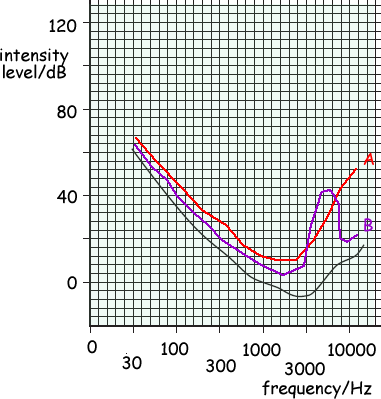'A' Level Medical Option Questions - The Ear
Q11.
(a) Define the threshold of hearing, I0
The threshold of hearing is the minimum intensity (at which a note of 1.0 kHz  ) can be detected by a normal ear.
) can be detected by a normal ear.
(2 marks)
(b) A hearing test was used to obtain threshold hearing audiograms for several people. The audiogram shown below was obtained for a person with normal hearing.

On the audiogram:
(i) sketch a curve, labelled A, for a person suffering hearing loss due to old age
Increased loss with increased frequency 
- just above the 'normal' trace for lower frequencies (indicating some loss) then well above the curve for higher frequencies (indicating more loss at higher frequencies).
(1 mark)
(ii) sketch a curve, labelled B, for a person suffering hearing loss due to excessive noise
Slight loss at all frequencies  but a marked 'notch' of severe loss at 4 kHz.
but a marked 'notch' of severe loss at 4 kHz.
- just above the 'normal' trace for all frequencies (indicating some loss) then climbing well above the curve for the region around 4 kHz - returning to being just above the normal trace for much higher frequencies.
(2 marks)
(Total 5 marks)


